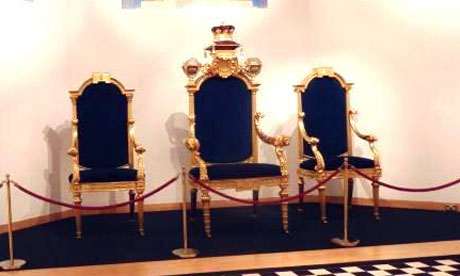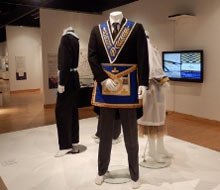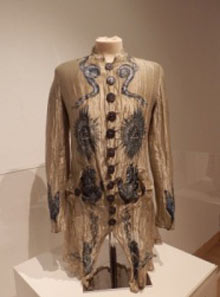Some still believe that by denuding fraternal orders of their mystery, spirituality, character and exclusiveness that they will make themselves more popular. Just the opposite is true. This article from the Guardian:
Freemasonry exhibition throws light on mysterious order
Carlisle museum looks at the symbolism and history of freemasonry in England over the last 300 years

George IV's freemason's throne.
But an exhibition at Carlisle's Tullie House – probably the most extensive public gallery exhibition ever devoted to the subject – attempts to nail down some facts amid the murk.
The exhibition's title, Into the Light, alludes both to the attempt to throw light on the "order" and to a stage of initiation when a new mason's blindfold is removed.
In a voxpop video at the entrance to the exhibition, Edna Croft attempts to sum-up freemasonry: "It used to be rather sinister and secretive, but they've made desperate attempts to prove they're just a charity."
 Masonic costumes.
Masonic costumes.
Sandy McKay said people in public office should declare their membership. From 1998 it was compulsory for judges and magistrates to register membership, but Jack Straw, as home secretary, abolished that rule in 2009.
The origins of freemasonry are obscure. Although a 1730 book traced the organisation back to ancient Egypt, it is now thought most likely that it derives from 17th century guilds of master masons, which later became open to all professions.
The symbolism of the stonemason is still widespread in freemasonry, with set square and compasses frequently appearing on aprons and other ornaments, often with the addition of an "all-seeing" eye.
There are some 250,000 members of lodges affiliated to the United Grand Lodge of England. In Carlisle alone there are 14 lodges, typically with around 50 members.
 A dress with masonic symbolism by John Galliano.
In England there are three orders of membership, who all wear
different colours to signify their rank – so lodge stewards wear red,
grand officers dark blue and gold and ordinary members sky blue.
A dress with masonic symbolism by John Galliano.
In England there are three orders of membership, who all wear
different colours to signify their rank – so lodge stewards wear red,
grand officers dark blue and gold and ordinary members sky blue.In Scotland there are 33 different orders of membership, so if they too have to wear different colours, lodge meetings in Scotland must be somewhat polychromatic.
The list of notable freemasons includes some surprising names, from Wellington and Walter Scott to Simon Bolivar and Mozart. Mozart's The Magic Flute, with libretto written by fellow freemason Emanuel Shikanader, has several overtly Masonic themes. Other Masonic works by Mozart include some Masonic funeral music and a choral cantata, The Mason's Joy.
It is possible for men of good character who are over 21 and believe in a Supreme Being to become members. Women need not apply in England or Wales - although there are a four all women and mixed lodges, they are not officially recognised by the United Grand Lodge, for reasons that are not explained.
Among the displays are Donald Campbell's apron, Winston Churchill's leather apron pouch, a frock with masonic motifs by John Galiano, as well as a lodge banner dating from 1796.
Most impressive, perhaps, are the seats borrowed from the United Grand Lodge in London's Covent Garden. These are huge throne-like chairs of gilded lime wood, made in 1791 at a cost of 150 guineas.
The largest central throne was made for the then Prince of Wales, later George IV. Even for the notoriously over-weight prince with his capacious backside, the throne must have been more than roomy.
• Into the Light: the Story of Freemasonry is on at Tullie House, Carlisle, until 7 July.


No comments:
Post a Comment